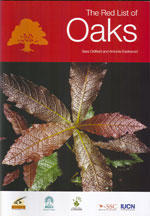|
THE RED LIST OF OAKS
Oaks are of global importance economically, ecologically and symbolically. They have been a major source of timber and coppice wood for centuries and continue to provide a significant proportion of temperate hardwood production. Other useful products derived from oaks include fuelwood, charcoal, medicinal products, dyes, cork and bark. Acorns have provided food in times of famine and continue to provide animal fodder. Many species of oak are grown ornamentally around the world.
The Red List of Oaks, published in 2007 by Botanic Gardens Conservation International (BGCI) and Fauna & Flora International (FFI) through the Global Trees Campaign (GTC), provides conservation status assessments for 208 of the 500 species found worldwide, according to the IUCN Categories and Criteria. Of these, 13 species were categorised as Critically Endangered, 16 as Endangered and 27 as Vulnerable. Unfortunately, insufficient information was available for over half the known species of oak to allow assessments to be made and the report recommends field surveys and research to plug these information gaps.
The report shows that major threats to oak species include habitat destruction, livestock grazing and unsustainable use. In Mexico, which has the highest diversity of oak species (160 species, 109 of which are endemic), land clearance for coffee plantations and cattle grazing are threatening large areas of oak forest. In other countries, climate change and invasive species, such as the fungus responsible for Sudden Oak Death Phytophthora ramorum, are just some of the threats contributing to oak decline.
To download the full report, click here - The Red List of Oaks - pdf
Back to Tree Red Listing
|
 |







